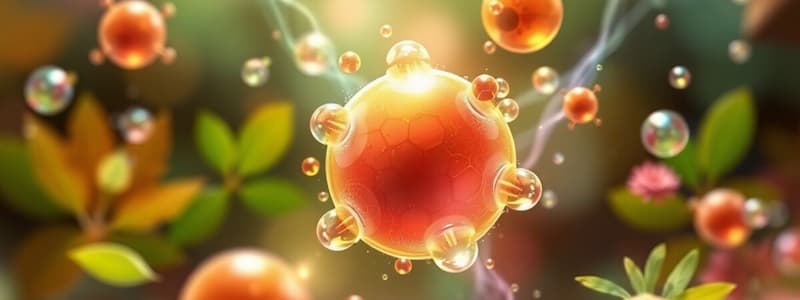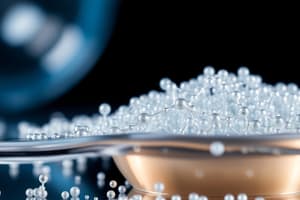Podcast
Questions and Answers
What role do phenolic acids play in the synthesis of NPS?
What role do phenolic acids play in the synthesis of NPS?
- They form Ag clusters through aggregation.
- They act as reducing agents. (correct)
- They stabilize the NPS.
- They serve as a source of ions.
Which method can be used to characterize NPS based on their crystallographic structure?
Which method can be used to characterize NPS based on their crystallographic structure?
- UV-Vis Spec
- FTIR
- TEM
- XRD (correct)
What does the color change during the NPS synthesis indicate?
What does the color change during the NPS synthesis indicate?
- Synthesis and stabilization of NPS. (correct)
- The process is complete.
- The NPS are unstable.
- Reduction of metal ions has failed.
Which plant is noted for producing spherical NPS when using In2O3?
Which plant is noted for producing spherical NPS when using In2O3?
What is the primary benefit of using a bottom-up approach in synthesizing NPS?
What is the primary benefit of using a bottom-up approach in synthesizing NPS?
What metal ions are specifically identified for usage in synthesizing NPS from Aloe vera?
What metal ions are specifically identified for usage in synthesizing NPS from Aloe vera?
During the NPS synthesis process, what is the significance of clapping?
During the NPS synthesis process, what is the significance of clapping?
Which reducing agents from plants are mentioned as contributing to the reduction and stabilization of NPS?
Which reducing agents from plants are mentioned as contributing to the reduction and stabilization of NPS?
Flashcards
NPS Synthesis
NPS Synthesis
The process of creating nanoparticles of metals using plant extracts as reducing agents.
Reducing Agent
Reducing Agent
A substance that helps reduce metal ions to metal atoms in nanoparticle synthesis.
NPS Characterization
NPS Characterization
Using methods (like XRD, TEM) to learn about NPS size, shape, and structure.
Bottom-Up Approach
Bottom-Up Approach
Signup and view all the flashcards
Clapping
Clapping
Signup and view all the flashcards
Metal Ions Reduction
Metal Ions Reduction
Signup and view all the flashcards
Plant-Based NPS
Plant-Based NPS
Signup and view all the flashcards
Nucleation
Nucleation
Signup and view all the flashcards
Study Notes
Nanoparticles Synthesis by Plants
- Plant-based methods for producing nanoparticles are environmentally friendly, using low temperature and energy, and avoiding toxic chemicals.
- Plant metabolites (compounds) act as reducing and stabilizing agents in nanoparticle synthesis.
- Different plant extracts and parts can produce nanoparticles of varying shapes and sizes.
- Reduction of metal ions to metal atoms is a key step.
- Plant extracts are used to reduce and stabilize metal ions, forming nanoparticles.
- Nanoparticles are characterized by X-ray diffraction (XRD), Fourier transform infrared spectroscopy (FTIR), UV-Vis spectroscopy, transmission electron microscopy (TEM), and scanning electron microscopy (SEM).
Synthesis of Nanoparticles from Plants
- Plant compounds like phenolic acids, flavonoids, and naphthalenones are used for reduction and stabilization.
- Xanthones, phloroglucinols, and naphthalenones contribute to the stabilization of nanoparticles.
- Nanoparticle size and shape are determined by plant metabolites.
- Plant extracts, reducing agents, and stabilizing agents can control NP synthesis.
- Some plants used include Aloe vera, Mangifera indica, and Eucalyptus macrocarpa.
- Silver nanoparticles, produced from silver ions, are a common example.
Characterization of Nanoparticles
- Techniques like XRD, FTIR, UV-Vis, TEM, and SEM are used to study nanoparticle properties.
- The size and shape of nanoparticles (e.g., spherical, hexagonal) are analyzed.
- Properties like size and shape are important factors determining application and functionality.
Green Synthesis of Nanoparticles
- Plant-based NP synthesis is considered an environmentally friendly method compared to traditional techniques using non-biological approaches.
- Plant metabolites, such as terpenoids, flavonoids, or tryptophan and tyrosine, aid in this process.
- The synthesis utilizes easily available plant materials for reduction and stabilization.
- Nanoparticles are characterized by various techniques (XRD, FTIR, etc.) to determine their formation.
Advantages of Plant-based NP Synthesis
- Environmentally friendly, using low energy, low temperature, and avoiding toxic chemistry.
- Easily available, inexpensive plant-based and natural resources.
- Fast and cost-effective nanoparticle synthesis.
Disadvantages of Plant-based NP Synthesis
- Some processes might require careful control of reaction parameters.
- There can be fluctuations in product yield when plant extracts are used.
- Possible variations depending on the type of plant material.
Studying That Suits You
Use AI to generate personalized quizzes and flashcards to suit your learning preferences.




